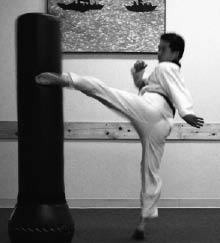Complete Kicking (23 page)
Authors: Turtle Press

SPORT APPLICATION: Against a left axe kick, when the opponent drops his head forward, counter with a back kick.
A powerful back kick is an audience pleasing demonstration skill. If you time your kick and the reaction of your partner well, the result is awesome, artistic and entertaining.
Back kick on the ground is frequently used in arranged step sparring in traditional schools and is a good way for students to practice the correct angle, distance and force control for back kick.
common mistakes
MISTAKE 1: The most common mistake is exposure of the hip, on which your opponent can land a pushing kick counter.
SOLUTION: This problem can be solved by turning your body more to the side and aligning the kicking foot, hip and shoulder on one plane.
MISTAKE 2: Another common problem is exposure of the groin and chest areas to the opponent’s counterattack.
SOLUTION: This can be solved by closing your chest a little bit (turning it away from the target) and keeping the toes of the kicking foot slightly lower than the heel.
To kick higher it is acceptable to lower your torso, however, you should still look at the target, align your body on one plane and keep your weight neutrally centered over your standing leg.
• remember
1. Turn your body to the side.
2. Shift your weight to neutral position.
3. Spot the target over your shoulder.
4. Align your body for maximum length.
5. Withdraw your foot in reverse of the way you kicked.
• avoid
1. Exposure of your hip
2. Exposure of your face and chest
3. Misalignment of the body
4. Over-rotation
TURN KICK
purpose
Turn kick is used to attack deceptively, to add the power of spinning to roundhouse kick, or to counterattack while retreating. It is powerful enough to knock down an opponent and effective for penetrating defense. It is usually used in combination with double or triple kicks, a roundhouse kick or a back kick.
key points
Once you spot an opening, don’t hesitate; turn and kick in one smooth committed motion.
Stalling during the turn hinders balance and naturalness. Keep your torso upright and lower your center of the gravity.
striking area
Instep, ball, shin
targets
1. stomach
2. solar plexus
3. kidney
4. liver
5. neck
6. face
7. temple
how to
1. From fighting stance, shift your weight to the front leg.
2. Pivot your front foot, rotate your hip to the rear, toward the target, and then turn your torso in the same direction. Spot the target over your shoulder. Move your rear foot forward.
3. As your rear foot crosses your body, rotate your hip quickly toward the target, and chamber your kicking leg in the air.
4. Release your foot to the target and rotate your hip fully into your kick for maximum delivery of power.
Ideally, at the moment of impact, your torso and legs should make a triangular shape with the primary force traveling to the kicking leg. In the illustration above your standing foot and leg are the power base, your front side shoulder is the power stabilizer, your hip is the power hub, and your kicking leg and foot are the power transmitters.
IN MOTION, LITTLE THINGS MATTER:
1. Avoid crossing your feet.
2. Keep your knees slightly bent.
3. Avoid long strides. Use short, quick footwork when turning.
applications
Turn kick is mostly used in competition, either moving forward or while retreating. It is powerful and deceptive when done correctly, however, it is reserved for advanced practitioners due to the speed and coordination required. If you lose your balance while turning or misjudge the distance to the target, you’ll find yourself in trouble. To avoid problems, maintain good posture, turn your body quickly and smoothly, and complete the kick in less than a second, preferably in a half second or less.
Other books
Hidden Witness by Nick Oldham
Mistborn: The Well of Ascension by Brandon Sanderson
Trapped by Revenge: A Shelby Nichols Adventure by Colleen Helme
Border of the sun by Aditya Mewati
Voices of Chaos by Ru Emerson, A. C. Crispin
Wanted by Heidi Ayarbe
The Cottage by Danielle Steel
Make Me Weak (Make Me #1) by Megan Noelle
The Oilman's Daughter by Evan Ratliff
Nacida bajo el signo del Toro by Florencia Bonelli








